and historical purposes, all rights reserved.
This page is copyright© by
This page may not be sold or distributed without
the expressed permission of the producer.
I have no connection with any camera company.
This camera manual library is for reference
and historical
purposes, all rights reserved.
This page is copyright© by ![]() M. Butkus, NJ.
M. Butkus, NJ.
This page may not be sold or distributed without
the expressed
permission of the producer.
I have no connection with any camera company.
On-line camera manual library
If you find this manual useful,
how about a donation of $3 to:
M.
Butkus, 29 Lake Ave.,
High Bridge, NJ 08829-1701
and send your e-mail address
so I can thank you.
Most other places would charge
you $7.50 for a electronic copy
or $18.00 for a hard to read Xerox copy.
This will help me to continue to
host this site,
buy new manuals, and pay their shipping costs.
It'll make you feel better, won't it ?
If you use Pay Pal, use the link below.
Use the above address for a
check, M.O. or cash.
Back to main camera manual page
Problems opening PDF files or
printing problems
- click here
Ansco Pioneer 20
PDF version of this manual
- better printing

ANSCO COMPANY
BINGHAMTON, N. Y.
NEW YORK CITY
ANSCO BUILDING, 129-131 w. TWENTY-SECOND STREET
KANSAS CITY, MO.
920-922 GRAND AVENUE
SAN FRANCISCO, CAL.
171-173 SECOND STREET
TORONTO, CANADA
347 ADELAIDE STREET, WEST
ANSCO COMPANY
325 WEST JACKSON BOULEVARD, CHICAGO ILL.
ANSCO LIMITED
· 143-149 OBEAT PORTLAND STREET, LONDON, W., ENGLAND
How to Make Photographs
with the Ansco Vest Pocket No. 2
Do-not open or close or in any way tamper with
the mechanism of the ANSCO V-P No. 2 until you read these instructions, unless
its workings have been explained to you by the dealer. It is a finely adjusted
instrument and works easily, smoothly, and with precision. If any part sticks or
refuses to work, it will be a sign that it is not being handled properly. Do not
try to force any part.
The ANSCO V-P No. 2 takes a film cartridge for six exposures. The film is
designated as 4A ANSCO SPEDEX, which is a standard size in all makes of film
and may be obtained all over the world.
Loading with Film
 |
Open the back of the camera by releasing
the hinged catch at one end and removing the metal back, so as to have
access to the spool chambers.
Next, insert film spool in the spool holder at the end of the camera opposite the winding reel, swing spool holder into position, cut label on spool and unwind enough black paper to insert into slot of empty spool in the winding chamber; give the winding key a few turns to secure the paper and to keep it as taut as possible. The black paper must be threaded straight and should be started absolutely even, for if the paper does not wind true the film will overrun the flanges. |
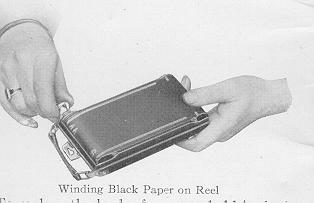 |
To replace the back of camera, hold its body with the left hand, and with the right hand hook the back on the dowels at one end, then close down and fasten the hinged catch. Next, turn winding key to the right until the figure 1 appears in front of the little ruby window. |
The Shutter and Lens
The ANSCO V-P No. 2 is furnished with two different kinds of
lens equipment, and Extra speed Bionic Shutter. It is necessary to become
thoroughly familiar with the working of the shutter before attempting to make
exposures if success is to be expected.
The shutter controls the rapidity with which the
picture is taken, and the rapidity must vary according to the strength of the
light and the size of the opening.
The graduated plate at the top of the shutter indicates the various exposures of
which the shutter is capable, expressed in fractions of seconds. The speed is
regulated by moving the pointer to the desired position on this scale. The
letters B and T. standing respectively for bulb and time, also appear upon this
plate, and are explained under the proper headings for bulb and time exposures.
The graduated plate at the bottom of the shutter is for the purpose of
regulating the size of the opening of the lens by moving the pointer to the
desired position. Moving the pointer from F 11 to F 16, indicates that the lens
opening has been reduced one-half, thereby necessitating double the length of
exposure, as only one-half as much light can then reach the film. The next
larger number indicates an increased diminution of one-half, or to one-fourth
the size of F 11 opening, requiring a corresponding increase of exposure time,
and so on.
The relation between the larger openings is expressed in the following table:
F6.3 is 1.6 times as large as F8
F7.5 " 2.3 " "
" " F11
F 8 " 2 ``
`` F 11
Exposure time should be calculated accordingly. Each of the remaining stops, 11,
16, 22, 32 is just one-half the size of the one immediately preceding it.
The lens equipments are:
F 7.5 Modico Anastigmat
The Modico Anastigmat lens is a lens of general application, which
is somewhat faster than a rapid symmetrical lens and the equal in definition,
flatness of field and freedom from astigmatism of the most expensive anastigmat
lens. It has a working speed F 7.5.
F 6.3 Ansco Anastigmat
The ANSCO Anastigmat lens is an anastigmat of the highest quality.
There is no one lens that will do every kind of work equally well, but the ANSCO
Anastigmat will do the greatest number of things best. It is of as nearly
universal application as possible. Its working speed is F 6.3.
 |
Extra speed Bionic Shutter
|
Extra speed Bionic Shutter
The diaphragm openings with Modico Anastigmat lens are F 7.5, 11, 16, 22 and 32 With ANSCO Anastigmat lens they are F 6.3 8, 11, 16, 22 and 32. The shutter is operated by a finger release which may be worked in any position, and in additional has a flexible wire plunger release. For the benefit of those persons who are unfamiliar with the F (focal) system of lens markings, the following table of Universal System equivalents is given:
| F 6.3 equivalent to | U. S. 2.6 |
| F 7.5 " | " U. S. 3.5 |
| F 8 " | " U. S. 4 |
| *F 11.3 " | " U. S. 8 |
| F 16 '` | U. S. 16 |
| *F 22.6 | U. S. 32 |
| F 32 | U. S. 64 |
Bubbles in Lenses
It is practically impossible to eliminate small air bells or bubbles in the
manufacture of optical glass for anastigmat lenses, because of the fact that in
the process of manufacture various chemicals must be fused together a given
length of time at a certain temperature. At the critical moment the process must
be stopped whether all the air has been driven out or not. This is necessary in
order that the optical qualities of the glass may be retained.
The small bubbles are caused by the air left in the glass, and
should be taken as a guarantee of quality rather than a detriment to a lens, for
the actual loss of light is inappreciable, and the bubbles even when near the
surface, have little or no effect on the optical quality of the image or the
speed of the lens.
MAKING THE EXPOSURES
Before making an exposure with an ANSCO V-P No. 2, either time
or instantaneous, be sure of four things:
First - That the shutter is set for the proper exposure.
Second -That the diaphragm stop is set at the proper opening.
Third--That the camera is focused.
Fourth--That an unexposed section of film is turned into position.
1. Instantaneous Exposures
All exposures the length of which is less than 1-25 second, which
is the slowest possible speed for satisfactory results when the camera is held
in the hand, are known as instantaneous exposures.
In making instantaneous exposures, or "snapshots," the following
rules apply:
FIRST--Set the top pointer at 1-25, 1-50, 1-100, or 1-200, according to the time
of the instantaneous exposure desired.
Note..--If very bright light, set the pointer at 1-200 or l-100, according to
the Subject. If less bright light, set it at 1-50 or 1-25, but do not attempt to
make any instantaneous exposures below 1-25 second.
SECOND--Set lower pointer at F 11. This lever controls the iris diaphragm, and F
11 is the proper opening for ordinary instantaneous exposures. For instructions
concerning the use of stops or diaphragm openings, see page 13.
NOTE. - For instantaneous exposures - when the sunlight is unusually strong and
there are no heavy shadows, such as in views at the seashore or on the water,
use diaphragm F 16. With light clouds or slightly smoky atmosphere use F 8 at
1-100, or F 11 at 1-25 or 1-SO. With heavy clouds do not attempt instantaneous
exposures.
THIRD - Press the release. This makes the exposure.
2. Time Exposures
All exposures made in slower time than 1-25 second are known as time exposures,
and it is necessary in all cases to have the camera supported upon
something solid, to prevent any movement of the camera, which would result in a
blurred picture.
To make time exposures the following rules should be observed:
FIRST - Set top pointer at T (time). This adjusts the shutter for time
exposures.
Exposures of 1-10 second can be made automatically by setting the pointer at the
point indicated on upper scale of the shutter.
SECOND - Set the lower pointer at F 16, 22 or 32 as desired. For instructions
concerning the use of stops or diaphragm openings, see page 13.
THIRD--Press the release. This opens the shutter. When time is up, again press
release. This closes the shutter.
3. Bulb Exposures
The term "bulb exposure" is given to time exposures which the
operator desires to control by holding the shutter open at will, a single
pressure of the release opening the blades of the shutter, which remain open
until the pressure is removed.
The following rules govern the making of bulb exposures:
FIRST - Set the upper pointer at B (bulb). This adjusts the shutter for
bulb exposures.
SECOND - Set the lower pointer at F 16, 22 or 32, as
desired. For instructions concerning the use of stops or diaphragm openings, see
page 13.
THIRD - Press the release to open the shutter, and remove
pressure to close it. This makes the exposure. The shutter will remain open as
long as the pressure is maintained.
NOTE -- Do not oil any part of the shutter. In case of accident return
the shutter to your dealer for repairs, or to Ansco Company
Binghamton, N. Y.
As a general rule make exposures by pressing the wire plunger and not with the
finger release, as the wire release is less likely to jar the camera.
OPERATING THE CAMERA
Instantaneous Exposures-- - "Snapshots"
To take instantaneous pictures the object must be in bright
sunlight, but the camera should not. The sun should be behind the back or over
the shoulder of the operator.
Opening the Front
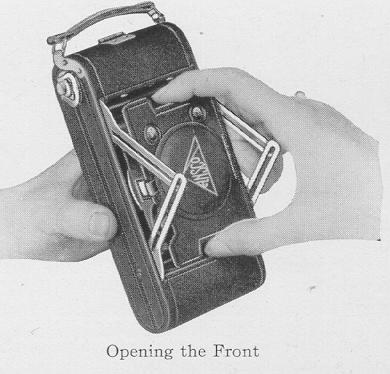 |
Holding the camera in the left hand, draw out the bellows with the thumb and middle finger of the right hand. When full extension is reached, the side arms will snap into place, automatically locking the front at that point. Open the watch-cover lid that protects the lens by releasing the spring snap at the top of the camera. Attach the wire release by threading it into the socket provided for it, which will be found beside the finger release. The ANSCO is then ready for focusing on the subject. |
Focusing
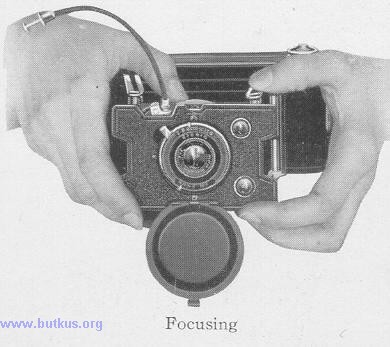 |
The ANSCO V-P No. 2 is equipped with a micrometer focusing device consisting of a milled disk and flange which permits accurate focusing for distances of 6, 8, 10, 15, 25, 50 and 100 feet. A small window at the top of the camera contains the focusing scale and pointer. The figures on the scale indicate the distance in feet. If it is desired to use an ANSCO V-P No. 2 as a fixed focus camera, the scale should be set at 25 feet and the diaphragm at F 11, or F 16. |
In photographing objects which are at a distance
of 25 or 50 feet, it is not necessary to estimate the distance any more than
with approximate accuracy. For instance, if the focus is set at 25 feet - the
usual distance for ordinary street work - the sharpest part of the picture will
be the objects at that distance from the camera, but everything from 15 to 65
feet will be in good focus. For general street work the focus may be kept at 25
feet, but when great sharpness or definition is required on any specific object
the exact distance should be ascertained and the pointer moved to the required
point on the scale. The best rule to follow in this case is to pace off the
required distance. The average person's step is about 3 feet. Do not try to
photograph any object nearer the camera than 6 feet, nor moving objects at a
shorter distance than 25 feet from the camera.
To photograph a high building at close range, it is necessary to secure a
position in an opposite building which will permit the camera to be pointed at
the center of the perpendicular lines of the building. If attempt is made to
photograph a high building while standing near by pointing the camera upward,
the side lines of the building will converge toward the top in the photograph,
thus spoiling the picture.
If the object be low down, like a small child or a dog, the camera should be
held down level with the center of the object.
Locating the Image
The ANSCO V-P No. 2 is equipped with two brilliant view finders, one for
horizontal and the other for vertical pictures. Locate the image in the finder
and aim the camera at the object to be photographed. For vertical pictures the
camera should be held upright after the focus is set, and the image located in
the vertical view finder. Always look into the finder from directly over it,
never at an angle.
To make an instantaneous exposure it is simply necessary to press the finger or
wire plunger release which opens and closes the shutter with one movement.
After making the exposure be sure to turn a new section of film into position.
Turn the key in top of camera slowly to the right until the next number appears
before the red window. Three or four turns will be sufficient to accomplish
this. The warning hand appears only before No. 1. Repeat the foregoing operation
for each picture.
Time Exposures - Interior
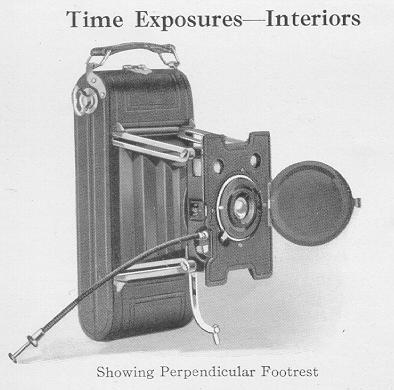 |
To make interior time exposures with the Ansco V-P No. 2, set the camera in such a position that the finder will embrace the view desired. The camera should not be pointed directly at a window, as the glare of light will blur the picture. If all the windows cannot be avoided, pull down the shades of such as come within the range of the camera. The camera should be placed on a table or other firm support. Center the object in the finder and set the shutter at T. One pressure of the release will open the shutter, and another will close it. The length of exposure is largely a matter of practice and judgment, and is governed by the amount of light on the object to be photographed. The length of exposure is also controlled by the size of the lens opening, or diaphragm, used. |
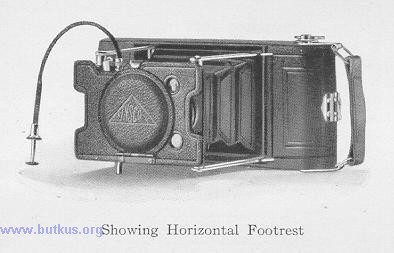 |
NOTED--When the Ansco V-P NO. 2 is to set on a table in upright position, bring down the extension footrest, which is located behind the shutter at the right side of the camera, as shown in illustration on page 10. When the camera is to stand on its side to make a horizontal picture, bring down the lever or footrest located beneath the shutter at the bottom of the camera as shown above. |
Time Needed for Interior Exposures
The following table is figured for exposures made between the hours
of 10 A. M. and 3 P. M., using diaphragm F 16. If stop F 11 is used, give only
one-half the time. If the stop or diaphragm F 32 is used, give four times longer
exposure. The smaller the stop, the sharper the picture. F 16 gives the best
results for interiors.
White Walls and More than One Window
Bright sunlight outside 4 seconds
Hazy sun
10 "
Cloudy bright
20 "
Cloudy dull
40 "
White Walls and Only One Window
Bright sunlight outside 6 seconds
Hazy sun
15 "
Cloudy bright
30 "
Cloudy dull ,
60 "
Medium Colored Walls and Hangings and More than One Window
Bright sunlight outside 8 seconds
Hazy sun
20 ''
Cloudy bright
40 "
Cloudy dull
80 "
Medium Colored Walls and Hangings and Only One Window
Bright sunlight outside .....2 seconds
Hazy sun
30 "
Cloudy bright
60 "
Cloudy dull
120 "
Dark Colored Walls and Hangings and More than One Window
Bright sunlight outside 20 seconds
Hazy sun
40 "
Cloudy bright
80
Cloudy dull 2 minutes 40 "
Dark Colored Walls and Hangings and Only One Window
Bright sunlight outside 40 seconds
Hazy sun
80 "
Cloudy bright 2 minutes 40
Cloudy dull 5 "
20 "
To Make a Portrait
Place the sitter in a chair partly facing the light and turn the face slightly toward the camera, which should be at the height of an ordinary table. Center the image in the finder. For a three-quarter figure the camera should be from 6 to 8 feet from the figure, and for a full figure 8 to 10 feet. The background should form a contrast with the sitter.
To Obtain a Larger Portrait
Use an ANSCO Portrait Attachment, which consists simply of an extra lens that
slips over the regular lens and in no way affects its operation except to change
the focus, thus enabling the operator to work closer to the subject. This makes
it possible to obtain a larger and sharply defined image on the film.
For all cameras which are fitted with a focusing arrangement the following table
applies:
With Focusing Indicator set at
6 ft. place subject at 2 ft. 2 in.
10
`` '` " " 2 ft. 6 in.
25 '` " " "
3 ft.
100 " "
" 3 ft. 6 in.
Time Exposures in the Open Air
Time exposures in the open air may be made provided diaphragm No.
32 is used. Exposures must be a little shorter than for interiors, as follows:
Diaphragm No. 32.
With sunshine
1-5 second
" light clouds from 1/4 to 1
" heavy " " 2
" 5 seconds
Use of Diaphragms
F 6.3 or F 7.5 for exposures at 1-25 second on cloudy or dull days
and for speed pictures at 1-200 second.
F 8 for instantaneous exposures on cloudy bright days.
F 11 for all ordinary instantaneous exposures at 1-50 or 1-100 second when the
sun shines.
F 16 for instantaneous exposures when the sunlight is unusually strong and there
are no heavy shadows, such as in views at the seashore or on the water; also for
interior time exposures, the time for which is given in the preceding table.
F 22 for interiors; never for instantaneous exposures.
F 32 for time exposures outdoors. The time required on cloudy days with this
diaphragm will range from 1-5 second to 5 seconds, according to the light.
Closing the Camera
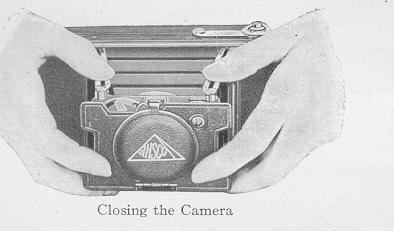 |
Before attempting to close the
camera be sure that the milled disk which operates the focusing device is
turned to the left to the limit of motion (beyond the mark 100); that the
lens cover is closed, and that the footrests, if used, are back in place,
otherwise the camera will not close properly.
Remove the wire release by unscrewing it from the camera. Take hold of the side arms with both hands and pull them outward. This will disengage the front and allow it to be pushed back into its proper place flush with the body of the camera. |
Removing the Film
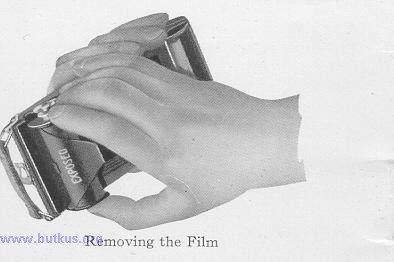 |
No darkroom is required for changing the spools in the ANSCO V-P
No. 2. The operation should, for absolute safety, be performed in a subdued
light.
I. When last section of film has been exposed, turn the key five half turns.
II. Provide an extra spool of film to fit the camera, and take a position by a table as far as possible from any window.
III. Remove the back
from the camera as directed on page 1.
IV. Holding the black paper taut, so as to wind tightly, turn the key until the
paper is all on the reel.
V. Fold over half inch at end of black paper (so as to make
subsequent breaking of the seal easy) and then seal with the gummed sticker that
will be found on the empty spool.
VI. Swing winding key with spool holder outward and remove the exposed roll by
springing out the ends of the spool holder.
VII. Wrap up the exposed film immediately to prevent the possibility of
admitting light.
VIII. Take the empty spool from the spool holder and place it in the other
holder to form the winding reel. The slotted end of the spool should first be
placed upon the end of the winding key and then the other end inserted on the
spool pin.
IX. Reload as directed on page 1. The roll of exposures can now be mailed or
taken to the dealer for finishing or you can do the developing and printing
yourself.
Developing and Printing
The ANSCO FILM BOOK is a complete treatise on the art of making
perfect negatives.
The CYKO MANUAL is a 64-page handbook on print making.
These books are both free on application at any ANSCO store, or to
ANSCO COMPANY BINGHAMTON, N. Y.
ANSCO SPEEDEX FILM--The Film which combines speed and quality. Obtain an Ansco
Speedex Film Booklet for complete directions in making perfect negatives.
CYKO PAPER--After the negative comes the finished print. The Cyko Manual is a
complete text book on the art of producing perfect prints.
YOURS FOR THE ASKING - If you have neither of the above mentioned books
and your dealer is out of them, write to us for one or both.
ANSCO CHEMICALS--For best results on Ansco Speedex Film and CyRo paper use Ansco
chemicals. They are carefully standardized and compounded under the supervision
of expert chemists.